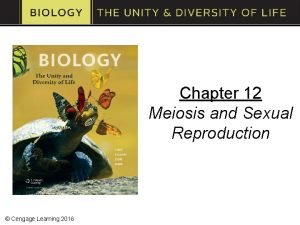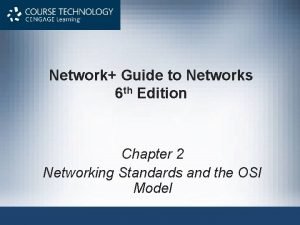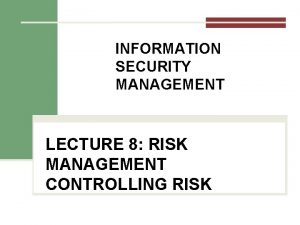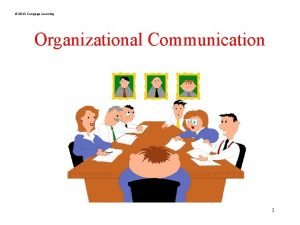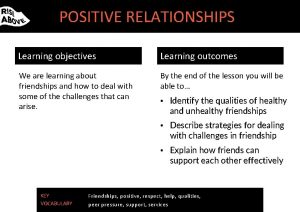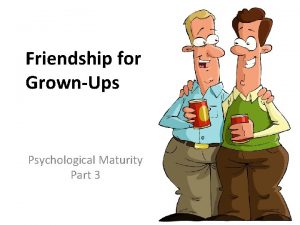Chapter 9 Friendship and Love 2015 Cengage Learning



















































- Slides: 51

Chapter 9 Friendship and Love © 2015 Cengage Learning. All Rights Reserved.

The Ingredients of Close Relationships LEARNING OBJECTIVES • Describe typical characteristics of close relationships. • Explain the paradox of close relationships. © 2015 Cengage Learning. All Rights Reserved.

Perspectives on Close Relationships • The Ingredients of close relationships – Close relationships – “are those that are important, interdependent, and long lasting. " – They come in many forms, including: o Family relationships o Friendships o Work relationships o Romantic relationships o Marriage © 2015 Cengage Learning. All Rights Reserved.

Perspectives, continued • Close relationships arouse intense feelings that are both – Positive (passion, concern, caring) and – Negative (rage, jealousy, despair) • This is referred to as the paradox of close relationships. © 2015 Cengage Learning. All Rights Reserved.

Relationship Development LEARNING OBJECTIVES • Discuss the roles of proximity, familiarity, and physical attraction in initial attraction. • Understand the roles of reciprocal liking and similarity in getting acquainted. • Outline some commonly used relationship maintenance strategies, and explain what is meant by “minding” relationships. • Summarize interdependence theory and explain how rewards, costs, and investments influence relationship satisfaction and commitment. © 2015 Cengage Learning. All Rights Reserved.

Attraction and Development, continued Initial encounters • Three factors underlie initial attraction between strangers: 1. Proximity – we are more likely to become involved with people we are geographically, or spatially, close to. 2. Familiarity – the mere exposure effect states that positive feelings toward a person are increased the more often we see them. © 2015 Cengage Learning. All Rights Reserved.

Attraction and Development, continued 3. Physical attractiveness – This factor plays a key role in face-to-face romantic relationships as well as friendships. – However, cross-cultural research suggests it is not the most important factor, for both males and females. o Kindness and intelligence were ranked higher for both genders. © 2015 Cengage Learning. All Rights Reserved.

Attraction and Development, continued • What makes someone attractive? – Facial features o For women: “baby-faced” features, (large eyes, small nose), combined with “mature” features (prominent cheekbones) o For men: a strong jaw and broad forehead – Physique o For women: average weight, an “hourglass” figure, and medium-sized breasts o For men: broad shoulders and a slim waist – Expressive traits (large smile, high set eyebrows) are seen as attractive because they suggest friendliness – Grooming qualities are also desirable, including cosmetic enhancements (see Figure 9. 2) © 2015 Cengage Learning. All Rights Reserved.

Source: Retrieved from the American Society for Aesthetic Plastic Surgery (2011), www. surgery. org/media/statistics.

Attraction and Development, continued What makes people attractive, continued – Matching up on looks o The matching hypothesis – “proposes that people of similar levels of physical attractiveness gravitate toward each other. ” © 2015 Cengage Learning. All Rights Reserved.


Attraction and Development, continued What makes people attractive, continued – Attractiveness and resource exchange • In contrast, the resource exchange is an evolution-based theory proposing that “in heterosexual dating, males ‘trade’ occupational status for physical attractiveness in females. " © 2015 Cengage Learning. All Rights Reserved.


Attraction and development, continued Resource Exchange theory, continued • David Buss (1988) believes mating patterns depend on what each sex has to invest in terms of survival. – For men, reproductive opportunities are the most important, so they show more interest in sexual activity and physical attractiveness. – Parental investment theory (see Figure 9. 3) states women choose mates that will supply resources needed to support offspring for many years. © 2015 Cengage Learning. All Rights Reserved.


Attraction and Development, continued Getting acquainted • Two factors affect viability of relationships: 1. Reciprocal liking – “refers to liking those who show that they like you” 2. Similarity – we are drawn to those with similar qualities o This is true in friendships and romantic relationships, regardless of sexual orientation. Ø Similar attitudes play a key role © 2015 Cengage Learning. All Rights Reserved.

Attraction and Development, continued Established relationships • Maintenance of ongoing relationships – Relationship maintenance – involves “the actions and activities used to sustain the desired quality of a relationship” (see Figure 9. 4). © 2015 Cengage Learning. All Rights Reserved.

Adapted from Canary & Stafford, 1994

Attraction and Development, continued • Established relationships, continued – The process of minding relationships is an active process that involves • Using good listening skills • Knowing your partner’s opinions • Making positive attributions about your partner’s behavior – Expressing feelings of trust and commitment – Recognizing your partner’s support and effort – Being optimistic about the future of the relationship © 2015 Cengage Learning. All Rights Reserved.

Attraction and Development, continued Relationship satisfaction and commitment • What determines whether you will stay in the relationship or get out? – Interdependence or social exchange theory states that the decision is based on a “cost-benefit” analysis of the relationship’s outcome. If the rewards outweigh the costs, we stay. – Commitment is determined by two factors: 1. Relationship satisfaction is gauged by our comparison level – or “personal standard of what constitutes an acceptable balance of rewards and costs” o It is based on outcomes experienced in one’s own and others’ previous relationships © 2015 Cengage Learning. All Rights Reserved.

Attraction and Development, continued Interdependence theory, continued 2. The investments, or “things that people contribute to a relationship that they can’t get back if the relationship ends. " – Thus, putting investments into a relationship strengthens our commitment to it (see Figure 9. 5). © 2015 Cengage Learning. All Rights Reserved.


Friendship LEARNING OBJECTIVES • Summarize the research on what makes a good friend. • Describe some key gender and sexual orientation differences in friendships. • Explain the friendship repair ritual as a way of dealing with conflict in friendships. © 2015 Cengage Learning. All Rights Reserved.

Friendship, continued What makes a good friend? • Many factors are important, but a common theme is that good friends provide emotional and social support. Gender and sexual orientation issues • Women’s friendships are more emotionally-based; men’s are more activity-based. • Women discuss relationships and feelings; men discuss work, sports, and other activities. © 2015 Cengage Learning. All Rights Reserved.

Friendship, continued • In other countries, men have more intimate relationships, but this is not true in America: – Men are socialized to be self-sufficient, which limits self-disclosure – Fear of homosexuality is a concern – Men see each other as competitors • Boundaries between friendship and love relationships are more complex in gay relationships. • Lesbians and gay men are more likely to maintain social contact with former sex partners. • There is also less support from families and society. © 2015 Cengage Learning. All Rights Reserved.

Friendship, continued Conflict in friendships • The 3 steps of repair after conflict in friendship: 1. Reproach – the offended party confronts the offender and asks for an explanation. 2. Remedy - the offender takes responsibility and offers an apology. 3. Acknowledgement – the offended party accepts the apology and the friendship continues. © 2015 Cengage Learning. All Rights Reserved.

Romantic Love LEARNING OBJECTIVES • Clarify the research findings on the experience of love in gay and straight couples, and identify some gender differences regarding love. • Compare Sternberg’s triangular theory of love with theory of adult attachment styles. • Discuss the course of romantic love over time, including what couples go through as they dissolve a relationship. • Explain why relationships fail and what couples can do to help relationships last. © 2015 Cengage Learning. All Rights Reserved.

Romantic Love, continued Sexual orientation and love • Sexual orientation – “refers to a person’s preference for emotional and sexual relationships with individuals of the same gender, the other gender, or either gender. " • Most studies of romantic love suffer from heterosexism, “or the assumption that all individuals and relationships are heterosexual. " • Thus, less is known about homosexual relationships. • However, homosexual romance and relationships seem to be basically the same as those of heterosexuals. © 2015 Cengage Learning. All Rights Reserved.

Romantic Love, continued Gender differences • Counter to stereotype, men are actually more romantic than women and fall in love more easily than do women. • Women are also more selective when choosing a partner, a tendency that supports the “parental investment theory” of attraction. © 2015 Cengage Learning. All Rights Reserved.

Romantic Love, continued Theories of love • Sternberg’s triangular theory of love states that all loving relationships are comprised of some combination of three components: 1. Intimacy – warmth, closeness, and sharing 2. Passion – intense feelings (both positive and negative), including sexual desire 3. Commitment – “the decision and intent to maintain a relationship in spite of the difficulties and costs that may arise” – Eight types of relationships can result from the presence, or absence, of each of the three components. – The ultimate type of love is consummate love, in which each of the three components is present (see Figure 9. 7). © 2015 Cengage Learning. All Rights Reserved.

Source: From Sternberg, R. J. (1986). A triangular theory of love. Psychological Review, 93, 119 -135. Copyright © 1986 by the American Psychological Association. Reprinted by permission of the author.

Romantic Love, continued Romantic love as attachment • Hazen and Shaver (1987) draw a connection between attachment patterns early in life and three adult attachment types. 1. Secure adults (55% of participants) 2. Avoidant adults (25% of participants) 3. Anxious-ambivalent adults (20% of participants) © 2015 Cengage Learning. All Rights Reserved.

Romantic Love, continued Romantic love as attachment, continued • Bartholomew and Horowitz’s (1991) model of adult attachment styles is based on two factors: 1. Attachment anxiety, or “how much a person worries that a partner will not be available when needed”, and 2. Attachment avoidant – “the degree to which a person distrusts a partner’s good will and their tendencies to maintain emotional and behavioral distance from a partner. " • See Figure 9. 9 for the four styles this yields. © 2015 Cengage Learning. All Rights Reserved.

(Adapted from Brennan, Clark, & Shaver, 1998; Fraley & Shaver, 2000)

Romantic Love, continued Correlates of attachment styles • Securely attached people have more committed, satisfying, interdependent, and well-adjusted relationships. • Securely attached people seek and provide support when under stress. • Securely attached people have better mental health. • Stability of attachment styles – Longitudinal studies show moderate stability over the first 19 years of life and later in adulthood. – However, attachment styles can be altered by life events (both in a positive and negative direction). © 2015 Cengage Learning. All Rights Reserved.

Romantic Love, continued The course of romantic of love • Sternberg’s theory predicts that the strength of each of the three components of love varies across time (see Figure 9. 10). – Passion peaks early in a relationship and then decreases in intensity. – However, both intimacy and commitment increase as time progresses. © 2015 Cengage Learning. All Rights Reserved.


Romantic Love, continued The course of romantic of love, continued Why relationships end: 1. Premature commitment 2. Ineffective communication and conflict management skills 3. Becoming bored with the relationship 4. Availability of a more attractive relationship 5. Low levels of satisfaction © 2015 Cengage Learning. All Rights Reserved.

Romantic Love, continued The course of romantic of love, continued Helping relationships last: 1. Take plenty of time to get to know the other person before making a long-term commitment. 2. Emphasize the positive qualities in your partner and relationship. 3. Develop effective conflict management skills. 4. Find ways to bring novelty to long-term relationships. © 2015 Cengage Learning. All Rights Reserved.

The Internet and Relationships LEARNING OBJECTIVES • Clarify how differences between Internet and faceto-face interactions affect relationship development. • Describe the pros and cons of building intimacy online. • Discuss the role of the Internet in face-to-face interactions. © 2015 Cengage Learning. All Rights Reserved.

The Internet and Relationships, continued Developing close relationships online. • Online venues offer an attractive communication platform for individuals who might not otherwise comfortably interact face-to-face. – Internet groups can offer support for stigmatized individuals. – Internet groups can provide support for shy individuals. – Among people using online dating sites, the majority (52%) report positive experiences. – Similarity of interests and values are more important. – Enhanced self-disclosure through emails and instant messaging increases feelings of closeness. © 2015 Cengage Learning. All Rights Reserved.

The Internet and Relationships, continued Building Online Intimacy. • Research suggests that virtual relationships can be just as intimate as face-to-face ones, or even closer (Bargh, Mc. Kenna, & Fitzsimons, 2002). • However, problems include: – People misrepresenting themselves online (e. g. , regarding income, age, height or weight). – People post profiles that reflect their “ideal”, rather than their “actual” selves. © 2015 Cengage Learning. All Rights Reserved.

The Internet and Relationships, continued Moving Beyond Online Relationships. • Research shows that virtual relationships are just as stable as traditional ones. • While online communication is linked with closeness with existing friendships. • However, it is negatively associated with bestfriendships and excessive use can foster loneliness. © 2015 Cengage Learning. All Rights Reserved.

Application: Overcoming Loneliness LEARNING OBJECTIVES • Describe loneliness, and discuss its prevalence. • Explain how early experiences and current social trends contribute to loneliness. • Understand how shyness, poor social skills, and self -defeating attributions contribute to loneliness. • Summarize the suggestions for conquering loneliness. © 2015 Cengage Learning. All Rights Reserved.

Application: Overcoming Loneliness, continued The nature and prevalence of loneliness • Loneliness – “occurs when a person has fewer interpersonal relationships than desired, or when these relationships are not as satisfying as desired. " • Transient loneliness – temporary loneliness after experiencing a disruption in one’s social network. • Chronic loneliness – ongoing loneliness affecting those unable to establish relationships. © 2015 Cengage Learning. All Rights Reserved.

Application: Overcoming Loneliness, continued The nature and prevalence of loneliness, continued Loneliness is most prevalent among: • The young (especially homosexual teens) • Single, divorced, and widowed adults • The elderly • Individuals whose parents have divorced © 2015 Cengage Learning. All Rights Reserved.

Application: Overcoming Loneliness, continued The roots of loneliness • Early experiences – inappropriate behavior (aggressiveness, aloofness, competitiveness, or overdependence) in children can lead to rejection by peers. • Social trends – busy schedules and time spent watching television and using computers in our homes decreases potential interaction with others. © 2015 Cengage Learning. All Rights Reserved.

Application: Overcoming Loneliness, continued Correlates of loneliness • Shyness – “discomfort, inhibition, and excessive caution in interpersonal relations” • Shy people tend to: 1. Be timid in expressing themselves 2. Be overly self-conscious about how others are reacting to them 3. Embarrass easily 4. Experience physiological symptoms of anxiety © 2015 Cengage Learning. All Rights Reserved.

Application: Overcoming Loneliness, continued • Poor social skills – Lonely people tend to: • Evaluate others negatively • Show lower responsiveness to their conversational partners • Disclose less about themselves • Self-defeating attributional style – especially thinking negatively about social situations can cause people to behave in ways that confirm their negative expectations. • Lonely people also engage in more negative self-talk and foster ideas that perpetuate loneliness (see Figure 9. 15). © 2015 Cengage Learning. All Rights Reserved.

Source: From a paper presented at the annual convention of the American Psychological Association, 9/2/79. An expanded version of this paper appears in G. Emery, S. D. Hollan, & R. C. Bedrosian (Eds. ) (1981). New directions in cognitive therapy. New York: Guilford Press and in L. A. Peplau & D. Perlman (Eds. ) (1982). Loneliness: A sourcebook of current theory, research and therapy. New York: Wiley. Copyright © 1982 by John Wiley & Sons, Inc. and Jeffrey Young.

Application: Overcoming Loneliness, continued Conquering loneliness • Chronic loneliness is associated with a variety of mental and physical health problems. • Fortunately, loneliness can be overcome by trying the following: – Use the Internet to alleviate anxiety created by face-to-face interactions. – Avoid the temptation to withdraw from social situations. • Break out of the habit of the self-defeating attributional style. • Cultivate your social skills. • Consider seeking help from a counselor. © 2015 Cengage Learning. All Rights Reserved.
 Triarchic theory of love
Triarchic theory of love Chapter 13 medical math assignment sheet
Chapter 13 medical math assignment sheet Pharyngorrhea
Pharyngorrhea Love love jesus is love god greatest gift lyrics
Love love jesus is love god greatest gift lyrics Presentation about love and friendship
Presentation about love and friendship Delmar cengage learning medical terminology
Delmar cengage learning medical terminology Cengage learning heart diagram
Cengage learning heart diagram Cengage learning heart diagram
Cengage learning heart diagram South-western cengage learning
South-western cengage learning 2009 delmar cengage learning
2009 delmar cengage learning Cengage learning heart diagram
Cengage learning heart diagram Medical terminology learning exercises chapter 1
Medical terminology learning exercises chapter 1 Cengage learning australia
Cengage learning australia 2009 delmar cengage learning
2009 delmar cengage learning Cengage learning
Cengage learning Cengage learning
Cengage learning Wadsworth cengage learning
Wadsworth cengage learning Cengage learning
Cengage learning Cengage learning plant cell
Cengage learning plant cell Cengage learning
Cengage learning Cengage learning
Cengage learning Brooks cole cengage learning
Brooks cole cengage learning 2014 cengage learning accounting answers
2014 cengage learning accounting answers Cengage chapter 7
Cengage chapter 7 Cengage learning
Cengage learning Cengage learning
Cengage learning Chapter 6 skeletal system
Chapter 6 skeletal system Cengage learning
Cengage learning 2009 delmar cengage learning
2009 delmar cengage learning Cengage learning
Cengage learning 2012 cengage learning
2012 cengage learning Training evaluation
Training evaluation Cengage learning psychology
Cengage learning psychology Course technology cengage learning
Course technology cengage learning Course technology cengage learning
Course technology cengage learning Course technology cengage learning
Course technology cengage learning Course technology cengage learning
Course technology cengage learning 2016 cengage learning
2016 cengage learning Delmar cengage learning instructor resources
Delmar cengage learning instructor resources 2014 cengage learning
2014 cengage learning 2010 cengage learning
2010 cengage learning Silence between friends
Silence between friends Cengage chapter 7
Cengage chapter 7 Accounting chapter 13 study guide
Accounting chapter 13 study guide Chapter 8 the digestive system
Chapter 8 the digestive system Cengage chapter 5 medical terminology
Cengage chapter 5 medical terminology Cengage chapter 4 answers
Cengage chapter 4 answers Cengage medical terminology chapter 1
Cengage medical terminology chapter 1 Friendship learning objectives
Friendship learning objectives Cuadro comparativo entre e-learning b-learning y m-learning
Cuadro comparativo entre e-learning b-learning y m-learning The salvation of man is through love and in love
The salvation of man is through love and in love That you must love me and love my dog summary
That you must love me and love my dog summary



























